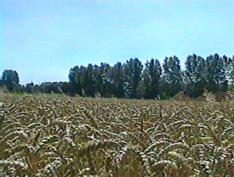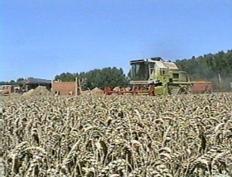
Besides its importance as one of the principal cereal crops which supplies energy in the diet, wheat is also "the first source of protein in developing countries".
World wheat reserves are in marked decline (FAOSTAT database). Consequently, it is important to improve the hardiness and nutritional quality of wheat within the perspective of sustainable agriculture, which would be more economic in terms of input and more environmentally-friendly. France, which is considered as the granary of Europe for soft wheat, is one of the main producers of wheat.
Besides its national and international economic importance, wheat has many distinctive scientific characteristics which make it an interesting model for the study of the organization and evolution of plant genomes (monocotyledons), in different contexts of polyploidy as well as under domestication and selection pressures.
Dynamic evolution of the wheat genome
 The wheat genome seems to have been
« invaded » by transposable elements (mainly retroelements), which constitute the major portion of this genome (80-90%). Furthermore, the genes do not seem to be distributed homogeneously over the wheat genome, but are grouped together as clusters or so-called gene-rich regions.
The wheat genome seems to have been
« invaded » by transposable elements (mainly retroelements), which constitute the major portion of this genome (80-90%). Furthermore, the genes do not seem to be distributed homogeneously over the wheat genome, but are grouped together as clusters or so-called gene-rich regions.
Several studies and analyses tend to show a process of dynamic evolution of the wheat genome, which implicates conflicting mechanisms of genome expansion and reduction (Petrov, 2001; Bennetzen, 2002). Mechanisms of genome expansion are often due to invasion of the genome by transposons and retrotransposons, as well as duplications of large genomic segments (Review: Bennetzen 2002; Wicker
et al., 2003b).
Mechanisms which conduct to a reduction in genome size or elimination of sequences are often due to unequal recombination events intra- or inter-retrotransposons, and the deletion of repetitive sequences (Review: Bennetzen 2002). In contrast with small genomes such as that of Arabidopsis, grapes or rice, that of wheat seems to be characterized by a distinctive dynamic evolution. A detailed study should lead to a better understanding of the consequences of this specific
« evolutionary strategy ».
Model for the study of the mechanisms of polyploidization
One of the main results of the sequencing programs for eukaryotes was the discovery that species which are considered as typically diploid (yeast, Arabidopsis thaliana and even humans) were originally, in fact, polyploid (paleopolyploids) which have undergone several cycles of polyploidization and chromosome doublings in the course of their evolution (Review: Wolfe, 2001).
 Polyploidy plays an important role in the evolution of eukaryotes and thus constitutes an important mechanism of diversification and generation of genetic variability. The majority of plants, including cultivated plants, are either relatively recent polyploids (such as colza, wheat, cotton, potato, alfalfa, etc.), or ancient polyploids, which still retain "vestiges" of ancestral polyploidization events (corn, soybean, cabbage, etc.).
Polyploidy plays an important role in the evolution of eukaryotes and thus constitutes an important mechanism of diversification and generation of genetic variability. The majority of plants, including cultivated plants, are either relatively recent polyploids (such as colza, wheat, cotton, potato, alfalfa, etc.), or ancient polyploids, which still retain "vestiges" of ancestral polyploidization events (corn, soybean, cabbage, etc.).
The reasons for the "success" of polyploidy in plants are not clear. In order to establish themselves as new species, the newly-formed polyploids must overcome the effects of pairing bias and bias due to chromosome segregation (Comai
et al., 2000; Ozkan
et al., 2001).
The hexaploid wheat (Triticum aestivum) is derived from two relatively recent polyploidization events between three clearly identified diploid species. The first event, which involves Triticum monococcum and (putatively) Aegilops speltoides, occurred about 0.5 million years ago, and led to the appearance of hard wheat (Triticum dicoccoides). The second polyploidization event took place about 9000 years ago, between hard wheat (tetraploid) and a third diploid (Triticum tauschii).
Wheat is an excellent model for the study of polyploidy and its effect on the evolution of genes and sequences in plants. Moreover, besides these natural polyploids, new varieties of wheat (Triticum) with different levels of polyploidy can be "synthesized" by crossing different diploid Triticum species.
Numerous studies in recent years on natural and synthetic wheat polyploids have characterized the direct effect of polyploidy on the evolution of genes and the regulation of their expression. Rearrangements in non-coding sequences have been observed in synthetic polyploids of Triticum ssp. and it has been assumed that these contribute to the process of genomic stabilization (Feldman
et al., 1997; Liu et al., 1998; Ozkan et al., 2001; Shaked
et al., 2001).
More recent research has demonstrated the effect of polyploidy on the regulation of the expression of several genes (using comparative cDNA-AFLP approaches) in synthetic tetraploids of Triticum ssp. (Kashkush
et al., 2002, 2003). This regulation of expression is partially due to epigenetic phenomena and silencing, but alto to the excision of genes and sequences. This suggests that gene losses (Feuillet
et al., 2001; Gautier
et al., 2000; Bornicki
et al., 1997) could be the result of evolution or divergence of genomes over time, but also of a rapid evolution by elimination of sequences following polyploidization.
The effect of polyploidy on the evolution of genomes may also be studied by comparative analysis of genomic sequences of species which are phylogenetically close, but have different levels of polyploidization. An illustrative example of this was recently described at a locus coding for low molecular weight glutenins (LMW) in Triticum ssp. The Am genome of Triticum monococcum contains three copies of tandem duplications at this locus, whereas the Ad genome of the tetraploid T. durum contains only one copy (Wicker
et al., 2003a). Surprisingly, except for the sequences of the LMW glutenin genes, the other regions compared did not display homology (Wicker
et al., 2003a).
Evolution under domestication and selection pressure
 Wheat has undergone domestication under selection pressures which changed it from a wild grass to a cultivated species with the present level of production. Partial sequencing will lead to an understanding of how these selection pressures act at the genome level, and in relation to the general process of adaptation to harvesting, adaptation to large geographical regions, to environmental stress and to various utilizations of the crop.
Wheat has undergone domestication under selection pressures which changed it from a wild grass to a cultivated species with the present level of production. Partial sequencing will lead to an understanding of how these selection pressures act at the genome level, and in relation to the general process of adaptation to harvesting, adaptation to large geographical regions, to environmental stress and to various utilizations of the crop.
Analysis of the sequences of representative regions of the genome should produce scientific information that will make it possible to determine statistically the effects of polyploidization, domestication and selection, and thus increase our knowledge of the organization of the wheat genome and will lead to inferences on gene expression.
The sequencing project
The sequencing project will cover representative regions of the wheat genome with the goal of comparing diploid Triticum species (T. monococcum and T. tauschii), a tetraploid species (T. durum), and the hexaploid (T. aestivum). The project will utilize French BAC library resources for hexaploid wheat (Renan and Chinese Spring) and chromosome-specific BAC libraries (URGV), as well as BAC resources from diploid and tetraploid species furnished by the University of California at Davis and the CSIRO. These BAC resources contain a total of over 3 million clones. They have been organized in a way to facilitate their exploitation and identify the clones of interest, either by PCR on pools of BAC clones, or by hybridization on 6 x 6 high density filters (42,600 clones in duplicate per 22 cm x 22 cm filter).
Genoscope will undertake the comparative sequencing of regions harboring genes and sequences of interest which have played a key role in the domestication of wheat and thus contributed to the founding of the first human civilizations.
About 100 BAC clones of average size 130 kb will be necessary for this project (6 BAC clones per region), which constitutes a sequencing volume of about 20,000 reads.
Genoscope will carry out the finishing step for these sequences.